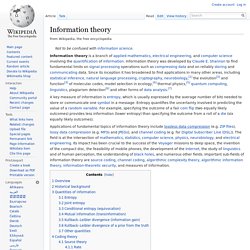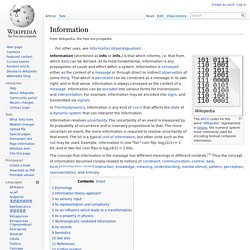

Consciousness. Representation of consciousness from the seventeenth century At one time consciousness was viewed with skepticism by many scientists, but in recent years it has become a significant topic of research in psychology, neuropsychology and neuroscience.

The primary focus is on understanding what it means biologically and psychologically for information to be present in consciousness—that is, on determining the neural and psychological correlates of consciousness. The majority of experimental studies assess consciousness by asking human subjects for a verbal report of their experiences (e.g., "tell me if you notice anything when I do this"). Issues of interest include phenomena such as subliminal perception, blindsight, denial of impairment, and altered states of consciousness produced by drugs and alcohol, or spiritual or meditative techniques. Etymology and early history[edit] John Locke, British philosopher active in the 17th century. A "Complex" Theory of Consciousness. IIT explains why consciousness requires neither sensory input nor behavioral output, as happens every night during REM sleep, in which a central paralysis prevents the sleeper from acting out her dreams.

Information theory. Overview[edit] The main concepts of information theory can be grasped by considering the most widespread means of human communication: language.

Two important aspects of a concise language are as follows: First, the most common words (e.g., "a", "the", "I") should be shorter than less common words (e.g., "roundabout", "generation", "mediocre"), so that sentences will not be too long. Such a tradeoff in word length is analogous to data compression and is the essential aspect of source coding. Second, if part of a sentence is unheard or misheard due to noise — e.g., a passing car — the listener should still be able to glean the meaning of the underlying message. Such robustness is as essential for an electronic communication system as it is for a language; properly building such robustness into communications is done by channel coding. Note that these concerns have nothing to do with the importance of messages. Historical background[edit] Resolving Uncertainty About Uncertainty: Information Theory vs. Diffusion of Innovation Theory. No Kee's it probably doesn't, I just include more steps in between ;) Thanks Kees, but I should warn you that I am looking beyond pattern matching as a model for how the "Meaning gets incorporated into the definitions".

I am currently writing an article on what I think the "Information Theory" for the human brain should be, and have if I remember correctly, 12 hierarchical layers of processing between the sensory input, and awareness. By eschewing pattern matching for the more uncertainty tolerant "Similarity Selection" model, a sort of Lazy pattern matching is possible that does not break with the redundancy and ambiguity, which often are required to overcome uncertainty, nor require optimal coding, or structurally static architectures. Uncertainty, means simply that there is a lack of certainty, caused by some information being hidden. Thank you Graeme, "Resolving Uncertainty About Uncertainty ? " Someting provokative: Well, you could, and in fact Bayesian Theory to some extent does. Information. The ASCII codes for the word "Wikipedia" represented in binary, the numeral system most commonly used for encoding textual computer information In Thermodynamics, information is any kind of event that affects the state of a dynamic system that can interpret the information.

Etymology[edit] The English word was apparently derived from the Latin stem (information-) of the nominative (informatio): this noun is derived from the verb informare (to inform) in the sense of "to give form to the mind", "to discipline", "instruct", "teach". Inform itself comes (via French informer) from the Latin verb informare, which means to give form, or to form an idea of.
Furthermore, Latin itself already contained the word informatio meaning concept or idea, but the extent to which this may have influenced the development of the word information in English is not clear. Information theory approach[edit] As sensory input[edit] Often information can be viewed as a type of input to an organism or system. Wave function collapse. When the Copenhagen interpretation was first expressed, Niels Bohr postulated wave function collapse to cut the quantum world from the classical.[5] This tactical move allowed quantum theory to develop without distractions from interpretational worries.

Mathematical description[edit] Mathematical background[edit] The quantum state of a physical system is described by a wave function (in turn – an element of a projective Hilbert space). This can be expressed in Dirac or bra–ket notation as a vector: The kets Where represents the Kronecker delta. An observable (i.e. measurable parameter of the system) is associated with each eigenbasis, with each quantum alternative having a specific value or eigenvalue, ei, of the observable. The coefficients c1, c2, c3... are the probability amplitudes corresponding to each basis . For simplicity in the following, all wave functions are assumed to be normalized; the total probability of measuring all possible states is unity: The process of collapse[edit] . .